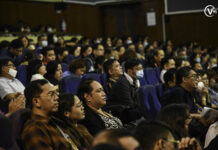THE UNIVERSITY plans to improve its flood control system to mitigate flooding on campus during the rainy season.
Rector Fr. Herminio Dagohoy, O.P. said UST plans to install water pumps along the streets parallel to España Boulevard to avoid jeopardizing heritage sites inside the University.
“We’re looking at the possibility of building [a] water litigation project, whichever is more feasible…the fastest way on how we could actually drain the [floodwaters],” Dagohoy said, referring to an underground water-impounding tank.
The University is looking at measuring the volume of flood water that flows inside the campus from streets with higher elevation.
“[What we] are eyeing depends on the computation [of] how much water comes into the University. For example, we are looking at two hours to four hours of continuous rain. The project could still hold the water and after that it could actually pump it out,” Dagohoy said.
Construction of the proposed water litigation project would likely be handled by the engineers who built the five-story underground tank of Burgos Circle at Bonifacio Global City in Taguig and the Facilities Management Office, the Rector said.
‘Heritage impact assessment’
Eric Zerrudo, director of the UST Graduate School Center for Conservation of Cultural Property and Environment in the Tropics, said a “heritage impact assessment” that includes feasibility studies should be conducted before constructing projects near historical sites.
“[The administration] must show to us [the impact and significance of the project] to the University,” Zerrudo added.
Mark Evidente, head of Cultural Heritage Society, said preservation of heritage sites in UST is a “general rule” and modifications need permission from government agencies such as National Museum and National Commission for Culture and the Arts.
“[These agencies will] tell you whether the proposed changes [are] respectful enough of the history and culture that embodies the area,” Evidente, an environmental lawyer, said.
He suggested digging a catch basin instead of installling water pumps in addressing the University’s perennial flood problem.
“UST should be responsible for the water that falls on its own property. It has to build a catchment basin for its own water,” Evidente said.
Dagohoy said water pumps might be used to recycle excess floodwater.
“We could actually use the excess water for the plants and recycle the whole thing. We can throw out the excess when we install the pumps,” Dagohoy said.
Dagohoy said the University was open to studying more options to mitigate flooding.
In 2013, the government proposed to dig a massive catch basin for flood water under the Open Field, but this was rejected by the UST administration to protect the area, which was declared a National Cultural Treasure in 2010.


















